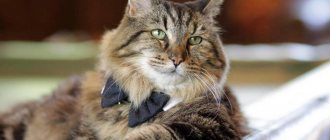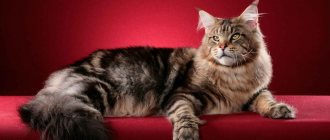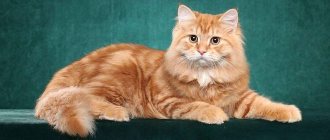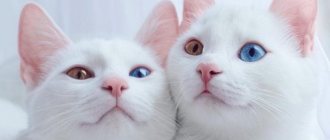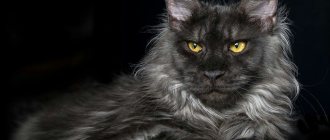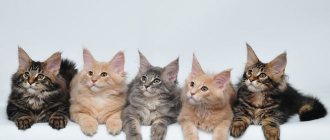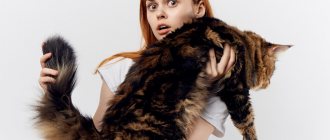Maine Coons have won the hearts of the people of our country since about the beginning of the 90s, and in their homeland in the USA, these large long-haired cats have been popular for at least 100 years. This is not surprising, given their easy-going disposition and unusual appearance: a powerful and long muscular body, thick fur, expressive eyes and charming lynx tufts on the ears.
Maine Coons are also interesting in terms of coat color: black, red, blue, cream, and, of course, white Maine Coons have their admirers. And we will focus on animals with snow-white fur coats.
White-haired Maine Coon
When they say that the Maine Coon is white, they mean the white solid color - one that assumes that the entire fur of the animal is uniformly colored in one color without any streaks, stripes or spots. Even small spots of a different shade on the fur coat (for example, cream or others) are considered a fault. At the same time, white Maine Coon kittens are sometimes born with small “colored” marks on the face or ears, but over time they disappear, and the fur becomes snow-white.
Photo: Maine Coon color white solid | Dreamstime.com
Looking at photos of white Maine Coons, it is impossible not to notice the beauty of these amazing large cats. Externally, their wool resembles fluffy angora fiber: it is just as soft and airy. And what is the long tail-fan with flowing hairs worth? But sometimes potential buyers refuse to buy a pet with a white fur coat, fearing the hassle of caring for it. However, it is unlikely that a white Maine Coon will require more care than, for example, a black or cream one. Pets of this breed are relatively unpretentious compared to other long-haired cats.
Tabby
Various stripes on the coat of cats are combined into one name - tabby. In addition, tabbies are identified by expressive rims on the animals’ faces, which very often form the letter “M”. This color is called wild because it resembles real wild cats that live in forest areas.
Maine Coons can have different coat colors and one of three basic tabby patterns:
- Classic (Mackerel tabby);
- Spotted tabby;
- Brindle (Mackerel tabby).
The ticked tabby pattern is also quite common, but unfortunately, it is not recognized for Maine Coon cats. All other tabby patterns can be of any color recognized by the systems.
Classic (marble)
The classic tabby pattern, or marbled as it is also called, consists of wide curls and various continuous lines on the animal’s body.
Maine Coon black marble on silver
Maine Coon black marble with white
Spotted
Spotted Tabby has intermittent stripes on the animal's fur that give the appearance of patterns of spots. The spot can be of any size and any degree of clarity.
Brindle (striped)
The brindle tabby is quite easily recognized due to the vertical stripes that run parallel. Maine Coons, which have brindle coat patterns, often resemble small tigers, which is not at all surprising, because domestic animals are genetically close to large predators.
Maine Coon brindle (Mackerel tabby)
Maine Coon classic (Mackerel tabby)
Maine Coon Spotted tabby
ticked
In this case, there are no spots or stripes. Ticked coloring can be recognized by the characteristic pattern on the cat's face and agouti throughout the body.
If you look closely at each hair of a cat with a ticked tabby, you can see two smoothly transitioning colors. This hair color is called agouti.
Ticked coloring may occur in Maine Coons, but such a pattern has not yet been officially approved as part of the breed standard. Black and gold ticked patterns are often found in Abyssinian cats.
Problems of Maine Coons "blond"
Some white Maine Coons have a defect called deafness
. The inability to hear the sounds of the outside world can occur when both or one of the kitten's parents has a special mutated gene responsible for white fur and blue eyes, although a white Maine Coon with blue eyes is rare, most often the eyes of these cats are green or amber - copper. One way or another, if blue-eyed cats are often completely deaf, then those who have heterochromic eyes (i.e., different colors, say, one eye is blue and the other green) are often deaf in only one ear (on the side that and blue eye). However, this does not mean that all “blond” Maine Coons cannot hear. Fortunately, not all white cats have a “dangerous” gene that is dominant, so the chances that the cat will be deaf are not one hundred percent. But it is better to know about this feature of white cats in advance.
Photo: White Maine Coon kitten with blue eyes |
Dreamstime.com In addition to hearing problems, it is white Maine Coons that are most susceptible to allergies
. There are many reasons for the appearance of such an unpleasant disease: poor-quality food, dust, parasite saliva, medications, chemical cleaning agents. Inattention to the manifestation of allergies also entails deterioration of the condition of the white fur coat due to constant scratching, discharge from the cat’s nose and eyes, and skin inflammation. To determine what your snow-white pet is allergic to, you will have to visit a veterinarian.
Feeding
Snow-white Maine Coons need high-quality food with a balanced and proven composition. If you decide to feed your cat dry food, then you need to carefully study its contents; the food should not contain components such as:
- beets, carrots;
- chicken and beef liver;
- copper, which is often found in feed;
- vitamins with dyes.
These rules also apply to natural food. It is not advisable to consume offal and buckwheat porridge. Fermented milk products will be useful; except for milk, it cannot be given to a cat. It is better to feed meat, fish and vegetables boiled, this way you can avoid infection with helminths. Sweet foods are contraindicated for Maine Coons because they are prone to allergic reactions.
How to keep your Maine Coon's coat white?
Although long-haired white Maine Coons do not require special care, like, for example, Persians, certain rules will have to be followed so that the fluffy coat does not lose its beauty:
- The eyes of white Maine Coons should not be wiped with furatsilin, tea leaves or herbal decoctions (chamomile, St. John's wort, etc.), otherwise yellow-brown spots will not be avoided. It is better to use boiled water for daily wiping. If the animal’s eyes are inflamed, you can wipe them with a cotton swab dipped in saline or boric acid solution - they will not leave a mark on the white fur;
- To prevent the white fur from turning yellow, you should monitor the cat’s diet. Liver, beets, seaweed, carrots, pumpkin, which the cat eats, contribute to the fact that the fur coat will sooner or later take on a stale yellow color. Moreover, the yellowing effect can manifest itself even if the listed products are contained in dry and canned food. If an animal takes vitamins, it is important not to overdo it with the elements iodine and copper, otherwise the fur will change color;
- Eating cheap economy food flavored with dyes has an extremely negative impact not only on health, but also on appearance. Saving and a white Maine Coon cat are incompatible concepts;
- Of course, poor grooming - infrequent brushing and bathing - can also worsen the appearance of the white coat. These cats need water treatments at least once every 3-4 months; it is also recommended to bathe Maine Coons during shedding. In this case, it is better to use special shampoos marked “for white wool” (like “White Cloud” from “Api-San” or “Shampoo for snow-white cats” from “Fitoelite” or others). Remove dead hair from white cats every day during shedding, and the rest of the time - a couple of times a week. For the face, you can use a brush with short teeth, and for the body - with large ones;
- Ectoparasites and any skin diseases (eczema, dermatitis, etc.) can significantly worsen the luxury of white wool. To avoid flea and tick infestations, the cat will need to be treated with insecticides. And if you suspect a skin disease (there are a lot of wounds on the body, the skin is inflamed, loss of appetite, etc.), you will have to pay a visit to the veterinary clinic. By the way, the fur of white cats looks untidy if helminths live in their bodies. In these cases, the fur coat is disheveled, with stuck together hairs, and the very appearance of the animal is painful. To avoid helminthic infestations, it is recommended to carry out deworming once a quarter, and for treatment - as prescribed by the veterinarian.
Unrecognized colors
Maine Coons of chocolate, gold, lilac, Siamese or any combination thereof are often not allowed to show.
There are also restrictions on the nature of coloring: colors and patterns that are found in Asian breeds are not recognized in raccoon cats. These include fawn, sorrel, cinnamon, point color, as well as any acromelanic colors. It is believed that oriental blood spoils the massive and powerful backbone of the Maine Coon. Ticked tabbies are also prohibited from showing.
Ticked Maine Coon
Maine Coon ticked color Breeders are diligently developing more and more new colors. Whether it's black markings on silver or blue markings next to white and tan spots, the famous wild colors will turn the Maine Coon into a real star of the show catwalk.
The Maine Coon breed truly delights with its variety of colors. Don't forget to help your pet properly care for its coat so that it always looks truly regal!
Natural selection
Animals with pure white fur are extremely rare in nature. This coloring makes them vulnerable and reduces their chances of survival due to the lack of necessary camouflage. Therefore, the opportunity to purchase white cats today has been preserved only thanks to breeders and interest in such pets on the part of buyers. In the world, these animals make up no more than 5% of the entire population.
Previously, when the problem was not yet so obvious, breeders sometimes did not even realize that their white cat could not hear. Then he gave birth to offspring, and the deafness spread further along the family line. Today, such cats are not used for further breeding, which has significantly reduced the rate of spread of the problem among white-haired fluffies.
Norwegian Forest Cats are white
What to do if the cat is deaf, how to ensure safety
When deafness occurs in ordinary cats, it is usually associated with a certain disease that can be cured. The story is different with white cats. Their defect is congenital. Therefore, it cannot be treated. But this does not mean that such a pet will please you less. He will certainly become everyone's pet, but such a cat will require special care:
- Do not let him go further than the house or fenced garden area.
- Avoid contact with other animals unless they live together.
- Develop a series of gestures that will replace voice commands and help the cat understand what the owner wants to say.
- Build the skill of maintaining eye contact through rewards and repetition.
Even in the absence of hearing, the kitten will very soon begin to distinguish family members by the different vibrations from their steps. Deaf cats love their owners no less than hearing cats. The main thing is to provide the pet with a safe habitat, because they do not hear many signs of approaching danger - yard dogs or cars.
1111
Factors that increase the likelihood of deafness in white cats
The figure shows the likelihood of a cat being deaf depending on the color of its fur and iris. Hearing defects may affect two ears, or may appear in only one.
Among the entire cat population, no more than 1.5% are found that have white fur and blue eyes, one or both. Their geographical distribution is uneven.
As a result of research, it was found that white cats with long hair are more likely to have hearing defects than their short-haired counterparts. In addition, blue-eyed cats are 5 times more likely to develop middle ear degeneration than cats with eyes of other colors. Having only one blue eye doubles the risk of developing deafness compared to cats that do not have both eyes blue.
White Cymric
As a result of natural selection, cats with white fur have virtually no chance of survival in the wild for several reasons:
- Due to the likelihood of deafness, the ability to live normally and hunt successfully is reduced.
- There is a risk of developing photophobia, which makes it difficult to stay in the sun.
- Blue-eyed animals have difficulty seeing normally in the dark.
But people liked white cats so much that today the demand for such kittens is very high. This type of color is found in almost every breed, and breeders have learned to test a cat for deafness using the BAER test, which can be performed at any veterinary clinic. If suddenly a defect is discovered, then such a cat will not participate in further procreation.
Foreign white


